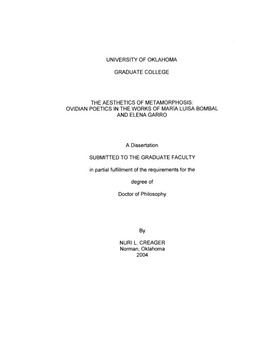| dc.contributor.advisor | Genova, Pamela A., | en_US |
| dc.contributor.advisor | Davis, Mary E., | en_US |
| dc.contributor.author | Creager, Nuri L. | en_US |
| dc.date.accessioned | 2013-08-16T12:19:21Z | |
| dc.date.available | 2013-08-16T12:19:21Z | |
| dc.date.issued | 2004 | en_US |
| dc.identifier.uri | https://hdl.handle.net/11244/705 | |
| dc.description.abstract | The study begins with an analysis of the Ovidian concept of metamorphosis and its effects on the body, identity, and the corpus of the text. Chapter Two addresses the notion of "literary myth, " and contextualizes Bombal's and Garro's work within a tradition that allows the authors to reinscribe and transform myths (both Western and Mesoamerican) in their texts. Chapter Three locates Bombal's Impressionistic aesthetic within French Symbolist and Post-Symbolist poetics, and establishes Bombal as one of the first novelists to translate its aesthetic for Latin America. Chapter Four provides an explication of Bombal's La ultima niebla through the interpretation of the myths of Narcissus, Orpheus, and Pygmalion---myths that illustrate her protagonist's psychic transformation and reveal a deconstruction of discourses on romantic love through parody and irony. Chapter Five both contextualizes Elena Garro within the avant-garde that characterized post-Revolutionary Mexico, and scrutinizes Garro's critical response to the ideology of liberation. Chapter Six explores textual and temporal transformations in Garro's Los recuerdos del porvenir, a work that reinterprets both the Surrealist myth of a golden age and the Mesoamerican myths of cosmic periodicity. The conclusion argues that, through the intertextual aesthetics of metamorphosis, these authors exploit the ambivalence of language in order to subvert essential notions of feminine identity and convey the paradoxes of Otherness, gender, and limitation. | en_US |
| dc.description.abstract | Maria Luisa Bombal's La ultima niebla and Elena Garro's Los recuerdos del porvenir represent two models of the evolving tradition of literary myth. Their novels offer examples of enigmatic female characters whose negations of reality are aesthetically rendered as transformations that end in either figurative stasis or literal petrification. Bombal and Garro revise some of Ovid's most fascinating myths in order to draw attention to the aesthetic dimension of their own complex texts, as well as to address fundamental questions concerning feminine subjectivity. | en_US |
| dc.format.extent | viii, 343 leaves ; | en_US |
| dc.subject | Women and literature Latin America History 20th century. | en_US |
| dc.subject | Latin American literature 20th century History and criticism. | en_US |
| dc.subject | Literature, Latin American. | en_US |
| dc.subject | Spanish American literature 20th century History and criticism. | en_US |
| dc.subject | Garro, Elena Criticism and interpretation. | en_US |
| dc.subject | Literature, Comparative. | en_US |
| dc.subject | Bombal, MarÔΩ̜a Luisa, 1910- Criticism and interpretation. | en_US |
| dc.subject | Latin American literature Women authors, Latin American History and criticism. | en_US |
| dc.title | The aesthetics of metamorphosis: Ovidian poetics in the works of Maria Luisa Bombal and Elena Garro. | en_US |
| dc.type | Thesis | en_US |
| dc.thesis.degree | Ph.D. | en_US |
| dc.thesis.degreeDiscipline | Department of Modern Languages, Literatures, and Linguistics | en_US |
| dc.note | Source: Dissertation Abstracts International, Volume: 65-02, Section: A, page: 0533. | en_US |
| dc.note | Directors: Mary E. Davis; Pamela A. Genova. | en_US |
| ou.identifier | (UMI)AAI3122289 | en_US |
| ou.group | College of Arts and Sciences::Department of Modern Languages, Literatures, and Linguistics | |
